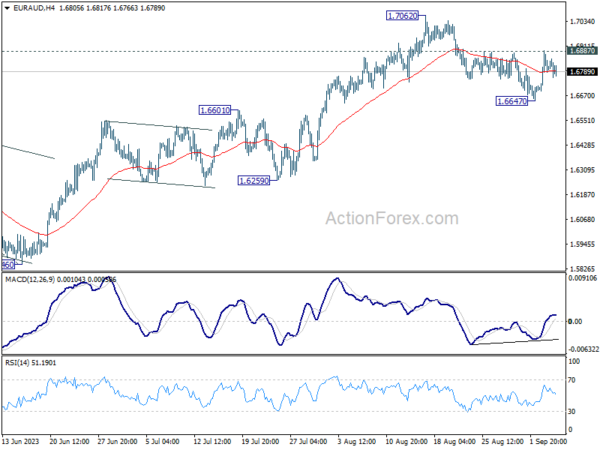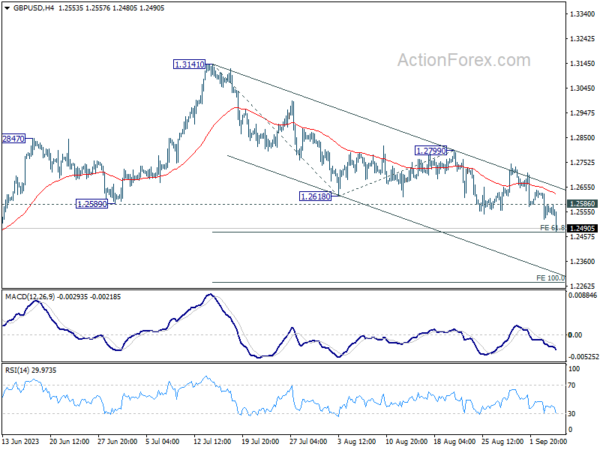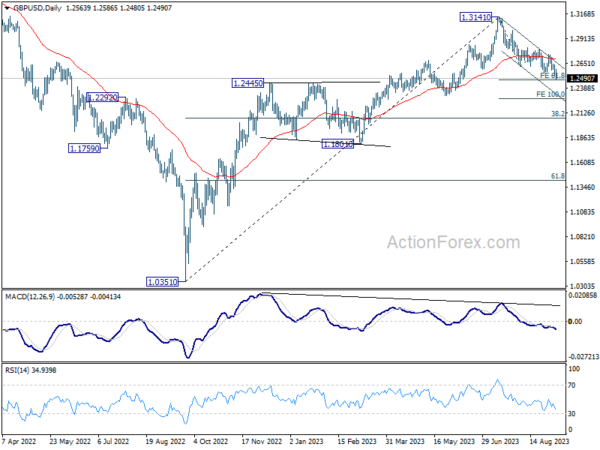Dollar Strengthens On Strong ISM Services; Canadian Dollar Steady After BoC Hold
Dollar is enjoying another rally, further solidifying its position as the strongest currency for the week so far, following an upbeat ISM Services report that well exceeded market expectations. The data affirms services sector’s dominant role in driving US economy. Additionally, it highlighted a robust uptick in both employment and prices, arguing the specter of services-led inflation looks set to linger.
Canadian Dollar holds steady after BoC opts to keep interest rates unchanged, a move widely anticipated by the markets. While Loonie emerges as the second-strongest currency for the week, this appears to be more a function of weakness in other currencies rather than inherent strength.
Euro is showing signs of resilience, ranking as the third-strongest currency. It is making an attempt to reverse its position against both Sterling and Swiss Franc. Australian and New Zealand dollars, continue to lag as the weakest performers. Yen has experienced a slowdown in its recent selloff, aided by increased verbal intervention from Japanese authorities.
Looking ahead, EUR/AUD would be an intriguing pair to monitor, especially given Aussie’s vulnerability to any negative surprises in the forthcoming Chinese trade balance data to be released at the upcoming Asian session. Moreover, rebounds in EUR/CHF and EUR/GBP could potentially bolster Euro in crosses.
Technically, firm break of 1.6887 resistance in EUR/AUD will confirm that correction from 1.7062 has completed. Further rally would then be seen through this resistance to resume larger up trend from 2022 low at 1.4281.
BoC stands pat, keeps hawkish bias
As anticipated, BoC keeps its overnight rate unchanged at 5.00%, alongside the Bank Rate at 5.25% and the deposit rate at 5.00%. Despite the steady rates, the tone of the announcement underscored ongoing concerns about inflation, coupled with a softer outlook on economic growth.
BoC explicitly stated that it remains “concerned about the persistence of underlying inflationary pressures,” signaling a continued tightening bias. In its words, the central bank is “prepared to increase the policy interest rate further if needed,” highlighting its willingness to act if inflation doesn’t abate.
US ISM services rose to 54.5, employment and prices jump
US ISM Services PMI rose from 52.7 to 54.5 in August, comfortably above expectation of 52.6. Looking at some details, business activity/production ticked up from 57.1 to 57.3. New orders rose from 55.0 to 57.5. Employment rose strongly from 50.7 to 54.7. Prices also rose from 56.7 to 58.9.
ISM said: “The past relationship between the Services PMI and the overall economy indicates that the Services PMI for August (54.5 percent) corresponds to a 1.6-percent increase in real gross domestic product (GDP) on an annualized basis.”
Fed’s Collins advocates patience and holistic data assessment
Boston Fed President Susan Collins struck a note of caution and restraint in today’s remarks, suggesting that while policy rates may be reaching their peak, further tightening could still be on the table, dependent on “holistic data assessment.”
“This phase of our policy cycle requires patience, and holistic data assessment, while we stay the course,” Collins asserted.
Collins emphasized the challenge of discerning meaningful trends in economic data, cautioning that “it is difficult to extract the signal from the noise.”
“If the improvement is fleeting, further tightening could be warranted,” she warned.
Most notably, Collins was reluctant to embrace the notion that recent improvements in economic indicators necessarily signal a taming of inflationary pressures.
“There are promising developments, but given the continued strength in demand, my view is that it is just too early to take the recent improvements as evidence that inflation is on a sustained path back to 2%,” she said.
ECB Kazimir prefers to hike next week, and take a breather thereafter
ECB Governing Council member Peter Kazimir offered two distinct pathways for the central bank’s next move, strongly advocating for a 25 bps rate hike in the upcoming meeting next week.
Kazimir laid out the two scenarios: either to pause during the September meeting and opt for a “hopefully final” hike in October or December, or to proceed with a 25 basis point increase immediately, and “take a breather thereafter.”
“The second option seems preferable, reasonable, to me,” Kazimir emphatically stated. According to him, taking the latter route would be a “more straight forward and efficient solution,” providing the markets with clearer signals. Furthermore, it would allow policymakers additional time to confirm that inflation is moving towards the 2% target in a sustainable manner.
Kazimir’s recommendation comes at a time when there are increasing uncertainties surrounding the economic outlook. He acknowledged that “forecasts for inflation and economic growth are yet to be updated,” but insisted on taking pre-emptive action. “It is, therefore, necessary to take one more step. As they say, better to be safe than sorry,” he remarked.
ECB Villeroy: Keeping rates sufficiently long counts more than hikes
ECB Governing Council member Francois Villeroy de Galhau refrained from detailing specific plans for the upcoming September 14 meeting. But he added, “I’m convinced we are close or very close to the high point of interest rates.”
Also, “In our fight against inflation, maintaining rates for a sufficiently long period now counts for more than further significant rises”, he said.
Villeroy also weighed in on inflation and economic growth trends, asserting that inflation passed its peak at the start of the year.” He added that recent fluctuations in oil prices “should not change the underlying dis-inflationary trend.” i
As for growth, Villeroy offered a measured outlook. “For the entire euro zone, we don’t see a recession today,” he noted. “The picture for France and the euro zone is slightly positive growth, slower growth,” Villeroy added.
ECB Knot: A further hike still a possibility, but not a certainty
ECB Governing Council member Klaas Knot made it clear that reaching 2% inflation target by the end of 2025 is non-negotiable. “I continue to think that hitting our inflation target of 2% at the end of 2025 is the bare minimum we have to deliver,” said Knot.
Knot didn’t rule out the possibility of further tightening on at September 14 meeting. “We’ve reached the finessing phase of the tightening cycle,” he noted. “Tightening—a further hike—is still a possibility, but not a certainty.”
The ECB member also underscored the importance of wage growth in achieving the central bank’s inflation target. According to him, “It’s quite crucial in the disinflation process toward 2% by the end of 2025 that wage growth decelerates visibly.”
Knot expressed concerns about current wage agreements, stating that they are “still pretty far off longer-run compatibility with a 2% inflation target plus half a percent productivity growth.”
Eurozone retail sales down -0.2% mom in Jul, EU fell -0.3% mom
Eurozone retail sales volume fell -0.2% mom in July, matched expectations. Volume of retail trade decreased by -1.2% mom for automotive fuels, while it increased by 0.4% mom for food, drinks and tobacco and by 0.5% mom for non-food products.
EU retail sales decreased -0.3% mom. Among Member States for which data are available, the largest monthly decreases in the total retail trade volume were registered in Denmark and Ireland (both -2.3%), the Netherlands (-1.4%) and Luxembourg (-1.3%). The highest increases were observed in Portugal (+1.1%), Sweden (+1.0%) and Cyprus (+0.8%).
Japan’s Kanda flags “high urgency” as Dollar bears 148 Yen
Japan’s Vice Minister of Finance for International Affairs, Masato Kanda, issued a strong warning as Dollar approaches 148 yen, marking a high for this year.
Kanda stated, “We are closely monitoring the situation, with a high sense of urgency. If such moves continue, the government will take appropriate measures, and all options are on the table.”
These remarks are the first significant warning since the Ten dropped below the 145-per-dollar mark in mid-August. Since then, Japanese authorities had been relatively silent.
With the declared “high sense of urgency”, Japan has effectively put currency traders on alert for potential intervention or other policy moves. The “all options are on the table” comment raises the possibility of multiple policy actions, ranging from more verbal warnings to more market interventions to curb yen’s fall.
Australia GDP grew 0.4% qoq on capital investment and services exports
Australia’s GDP saw 0.4% qoq growth in Q2, aligning perfectly with market expectations. This marks the seventh consecutive quarter of economic growth for the nation. The economy exhibited resilience with a 3.4% annual growth rate for 2022-23 financial year, comfortably surpassing 10-year pre-pandemic average of 2.6%.
However, it wasn’t all good news: nominal GDP dropped by -1.2% qoq in the June quarter. GDP implicit price deflator also fell -1.5%, primarily due to -7.9% decline in terms of trade. Export prices fell by -8.2%, exceeding -0.3% fall in import prices. Despite this, domestic price growth remained stable at 1.2%, buoyed by increases in household rents, food prices, and the cost of capital goods, which escalated due to Australian Dollar’s depreciation.
The positive quarterly GDP numbers were largely driven by two key factors: capital investment and the exports of services. Total gross fixed capital formation surged by 2.4%, reflecting growth in both public and private investment sectors.
Services exports soared 12.1%, with a significant push coming from 18.5% uptick in travel services.
Net trade in goods added 0.5% to GDP, with 2.5% rise in goods exports led mainly by mining commodities.
Household spending, on the other hand, remained rather muted, contributing just 0.1T to the GDP growth with modest 0.1% increase.
GBP/USD Mid-Day Outlook
Daily Pivots: (S1) 1.2517; (P) 1.2577; (R1) 1.2625; More…
GBP/USD’s decline continues today and hits as low as 1.2480 so far. Intraday bias remains on the downside. Firm break of 61.8% projection of 1.3141 to 1.2618 from 1.2799 at 1.2476 could prompt downside acceleration to 100% projection at 1.2276. On the upside, above 1.2586 minor resistance will turn intraday bias neutral first.
In the bigger picture, fall from 1.3141 medium term top is seen as a correction to up trend from 1.0351 (2022 low). Deeper decline would be seen to 38.2% retracement of 1.0351 to 1.3141 at 1.2075. Strong support would be seen there to bring rebound on first attempt. But outlook will be neutral at best as long as 1.3141 resistance holds, and consolidation from there is set to extend, until further development.
Economic Indicators Update
| GMT | Ccy | Events | Actual | Forecast | Previous | Revised |
|---|---|---|---|---|---|---|
| 01:30 | AUD | GDP Q/Q Q2 | 0.40% | 0.40% | 0.20% | |
| 06:00 | EUR | Germany Factory Orders M/M Jul | -11.70% | -4.30% | 7.00% | |
| 08:30 | GBP | Construction PMI Aug | 50.8 | 49.8 | 51.7 | |
| 09:00 | EUR | Eurozone Retail Sales M/M Jul | -0.20% | -0.20% | -0.30% | 0.20% |
| 12:30 | CAD | Labor Productivity Q/Q Q2 | -0.60% | -0.10% | -0.60% | |
| 12:30 | CAD | Trade Balance (CAD) Jul | -1.0B | -3.5B | -3.7B | |
| 12:30 | USD | Trade Balance (USD) Jul | -65.0B | -67.9B | -65.5B | -63.7B |
| 13:45 | USD | Services PMI Aug F | 50.5 | 51 | 51 | |
| 14:00 | USD | ISM Services PMI Aug | 54.5 | 52.6 | 52.7 | |
| 14:00 | CAD | BoC Interest Rate Decision | 5.00% | 5.00% | 5.00% | |
| 18:00 | USD | Fed’s Beige Book |
The Penny Drops: Understanding The Complex World Of Small Stock Machinations
Micro-cap stocks, often overlooked by mainstream investors, have recently garnered significant attention due to rising c... Read more
Current Economic Indicators And Consumer Behavior
Consumer spending is a crucial driver of economic growth, accounting for a significant portion of the US GDP. Recently, ... Read more
Skepticism Surrounds Trump's Dollar Devaluation Proposal
Investors and analysts remain skeptical of former President Trump's dollar devaluation plan, citing tax cuts and tariffs... Read more
Financial Markets In Flux After Biden's Exit From Presidential Race
Re-evaluation of ‘Trump trades’ leads to market volatility and strategic shifts.The unexpected withdrawal of Joe Bid... Read more
British Pound Poised For Continued Gains As Wall Street Banks Increase Bets
The British pound is poised for continued gains, with Wall Street banks increasing their bets on sterling's strength. Th... Read more
China's PBoC Cuts Short-Term Rates To Stimulate Economy
In a move to support economic growth, the People's Bank of China (PBoC) has cut its main short-term policy rate for the ... Read more




